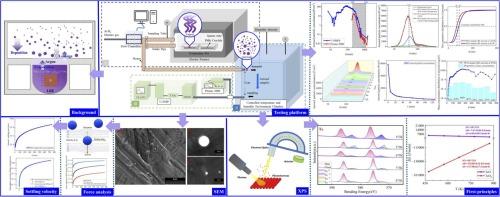掺杂铅碲的 LBE 气溶胶沉积行为与碲价预测:平台测试与第一原理计算
IF 12.2
1区 环境科学与生态学
Q1 ENGINEERING, ENVIRONMENTAL
引用次数: 0
摘要
在使用铅铋共晶(LBE)冷却剂的快堆研究中,了解反应堆内的源项及其环境迁移对于管理 210Po 气溶胶的辐射危害至关重要。利用经验参数进行的数值模拟对 210Po 气溶胶的理论迁移率和沉降率提出了见解。然而,平台测试的缺乏阻碍了粒度分布和沉降速度的获取,从而削弱了实验和理论验证之间的相互印证。本研究设计并建立了一个 LBE 气溶胶测试平台(LATP),以获取颗粒浓度数据来预测 210Po 迁移,其中 Te 被用作实验替代物。利用气溶胶光谱仪和通用扫描迁移率粒度仪测量了掺杂铅碲的 LBE 气溶胶的颗粒浓度和粒度分布函数,发现其粒度分布范围为 0 至 800 nm。在正常工作条件(873 K)下,气溶胶浓度的峰值粒径为 47 nm,而在事故条件(1223 K)下则变为 41 nm。值得注意的是,在这两种情况下,颗粒的最高质量浓度都在 200-300 nm 范围内。掺杂铅碲的 LBE 气溶胶的沉降速度随颗粒大小的增加而增加,范围在 5.0×10-7 到 7.1×10-5m/s 之间。第一性原理计算和 X 射线光电子能谱结果表明,掺杂铅碲的枸杞气溶胶在与氧气作用时应优先生成 TeO2。这项工作为严重事故下钋的迁移特性提供了合理的预测方法。本文章由计算机程序翻译,如有差异,请以英文原文为准。

Deposition behavior of PbTe doped LBE aerosol and Te valence prediction: Platform test and First-principles calculation
In fast reactor investigation with lead-bismuth eutectic(LBE) coolant, understanding the source term within the reactor and its environmental migration is crucial for managing radiation hazards from 210Po aerosols. The numerical simulations using empirical parameters have proffered insights into the theoretical migration and settling rates of 210Po aerosols. However, the scarcity of platform tests has impeded the acquisition of particle size distributions and settling velocity, thus weakening the mutual confirmation between experimental and theoretical validation. In this study, an LBE aerosol testing platform (LATP) was designed and established to obtain the particle concentration data to predict 210Po migration, where Te was employed as an experimental surrogate. The particle concentration and size distribution function of PbTe-doped LBE aerosol were measured by an aerosol spectrometer and a universal scanning mobility particle sizer, revealing the particle size distribution spanning from 0 to 800 nm. Under normal operating conditions (873 K), the pinnacle particle size of the aerosol concentration is 47 nm, which shifted to 41 nm under accident conditions (1223 K). Notably, the highest mass concentration of particles under both circumstances falls within the 200–300 nm range. The settling velocity of PbTe-doped LBE aerosol increase with the particle size, and ranging from 5.0 × 10−7 to 7.1 × 10−5m/s. First-principles calculations and X-ray photoelectron spectroscopy results indicate that PbTe-doped LBE aerosols should preferentially generate TeO2 during the interaction with oxygen. This work provide a reasonable prediction method for the migration characteristics of polonium under severe accident.
求助全文
通过发布文献求助,成功后即可免费获取论文全文。
去求助
来源期刊

Journal of Hazardous Materials
工程技术-工程:环境
CiteScore
25.40
自引率
5.90%
发文量
3059
审稿时长
58 days
期刊介绍:
The Journal of Hazardous Materials serves as a global platform for promoting cutting-edge research in the field of Environmental Science and Engineering. Our publication features a wide range of articles, including full-length research papers, review articles, and perspectives, with the aim of enhancing our understanding of the dangers and risks associated with various materials concerning public health and the environment. It is important to note that the term "environmental contaminants" refers specifically to substances that pose hazardous effects through contamination, while excluding those that do not have such impacts on the environment or human health. Moreover, we emphasize the distinction between wastes and hazardous materials in order to provide further clarity on the scope of the journal. We have a keen interest in exploring specific compounds and microbial agents that have adverse effects on the environment.
 求助内容:
求助内容: 应助结果提醒方式:
应助结果提醒方式:


